The aim of this thesis is to determine the importance of fur industry in the regions of Kastoria and Voio van Kozani (Siatista). In order to investigate the current situation and also the future of the fur industry, a quantitative research was conducted with a sample of 100 people involved in the fur industry.
Introduction
The crisis on the Russian market and the sharp drop in sales put the fur industry in a difficult situation. Very few young people are involved in the production of fur, compared to the development of the fur sector in recent years (Pouliopoulos, 1994).
Fur industry in Western Macedonia
Historical evolution
Current situation
The significant increase in China is probably the result of the memorandum signed during the 82nd Thessaloniki International Fair between the administrations of the "Kastoria - Prophet Elias Fur Association" and the Greek-Chinese Chamber. The aim of the memorandum is to lay the foundations for broad cooperation with China for the benefit of the industry and to strengthen the extroversion of products.
Financial contribution of fur industry
The number of fur companies is almost 3000 and represents 60% of the total activities of Kastoria and Siatista. The fur industry is one of the few in the country where 85% of product processing is still done by hand.
Fur farming legislation in European Union
The keeping of animals is also regulated in article 4 and 6 as "the owner must ensure the health and welfare and provide food, water and care suitable for the species and, where necessary, with shelter". Furthermore, the Act refers to farm animals in the chapters on "requirements for keeping animals" and on "the protection of animals at slaughter and killing".
SWOT analysis of fur industry
- Strengths
- Weaknesses
- Opportunities
- Threats
There is a heavy dependence on suppliers of fur raw materials, which are closely related to the operation of the auctions. Utilization of lifelong learning measures of the fur industry by training human resources of both workers and entrepreneurs.
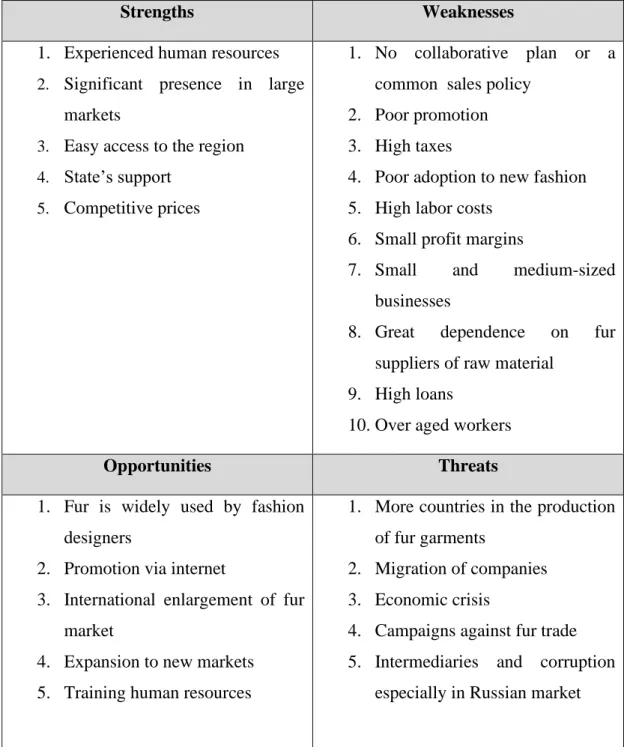
Research methodology
- Purpose and research questions
- The research method
- The research tool
- The research sample
- Reliability and validity
To carry out the quantitative research, a structured questionnaire was used, the structure of which is based on research questionnaires with the same or a similar topic, in order to increase the validity and reliability of the answers. In addition, this method of collecting primary data can guarantee the anonymity of the participants, contributing to the greater reliability of the answers. The first part of the questionnaire included demographic questions such as gender, age, position and professional experience.
The reasons that led to the choice of this type of question were the opportunity they give the researcher for easy comparison of the answers and their convenience in coding. The questionnaire was accompanied by a letter stating the purpose of the research and inviting participants to respond to this, both to ensure their anonymity and for the short time required. The sample is not considered to be representative of the population and this is a significant limitation of the research (Creswell, 2011).
The interviews took place simultaneously with the distribution of the questionnaire, after consultation with the participants. The researcher informed the aforementioned three persons in detail about the purpose and object of the research, and also asked them for permission to digitally record their answers, to which they did not consent.
The results of the research
Demographics of the participants
Specifically, 14% graduated Junior High School, 34% Senior High School, 32% have a university degree and 20% a Master's Degree or a Doctorate. Regarding their professional status in the fur industry, 73% are employees and 23% are business owners. Finally, the majority of the participants in the survey have been working in the fur sector for more than 20 years.

The significance of the fur sector
From the table and diagram below, we conclude that the majority of participants believe that the region's economy is very dependent on the fur industry. Specifically, 80% of the participants answered to a great or very great extent, while 17% answered to a medium degree and only 3% answered to a small extent. Specifically, 83% of the participants answered to a great or very great extent, while 14% answered to a medium degree and only 3% answered to a small extent.
The fourth question was about the fur industry's contribution to tourism development in the area. Based on the table and diagram below, we conclude that the majority of participants believe that the region's tourism development depends on the fur industry for one. In relation to the above question, we can see that the participants believe that the fur industry has probably not helped tourism to develop, probably because the majority of investments were mainly related to the fur industry, which did not leave room for other investments.
The contribution of the fur industry to the tourism development of the region Frequency Percent Valid Percent. The last question in this section was about investments in the region due to the fur industry.
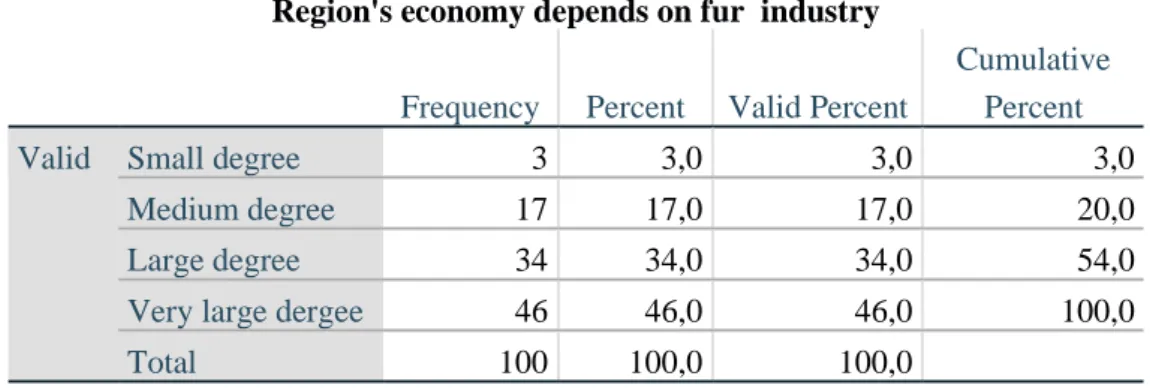
Current situation of fur industry
As the table and diagram below show, the situation in the fur industry was clearly better ten years ago than it is today. In concrete terms, 46% of participants characterize the current situation of the fur industry as much worse and 51% worse. Finally, as shown in the diagram below, the situation in the fur industry twenty years ago was clearly much better than it is today.
Regarding the economic crisis, 85% of the participants believe that the economic crisis has affected the fur industry to a very large or very large extent, while 12% answered to a medium extent and only 3% answered to a small extent . As for the reactions of animal lovers, it seems to affect the fur industry to a lesser extent. Specifically, 41% believe that these responses have affected the fur industry to a very large or very large extent, while 12% responded to a medium extent and 26% responded to a small extent or not at all.
Specifically, 88% believe that the pandemic has affected the fur industry to a very large or very large extent, while 8% responded moderately and 4% to a small extent or not at all. In this section's question, participants were asked to rate the way in which certain stakeholders support the fur industry in the Kastoria region.
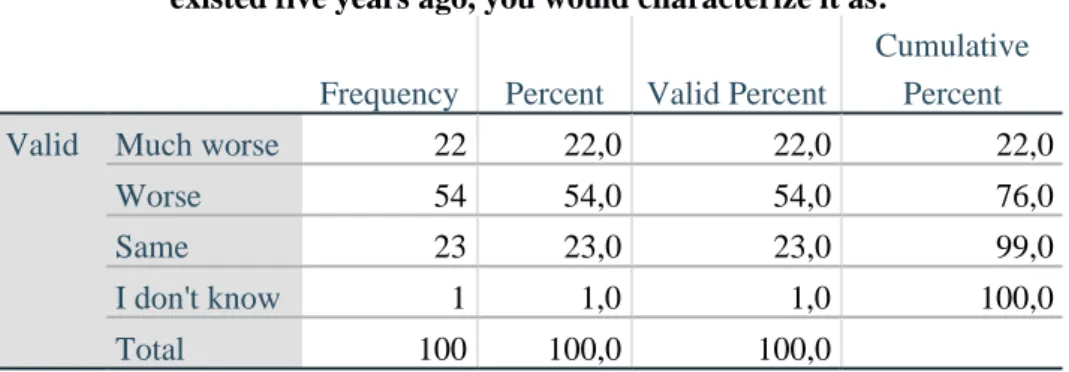
The future of fur industry
As long as it is cold and women appreciate beauty, the fur industry has a future.” Participants were then asked to answer the following question: “To what extent do you think the differentiation of the raw material (synthetic fur instead of real) will impact the following stakeholders?”. The next question concerned the differentiation of the raw material, from natural products to synthetic products.
More precisely, 69% of participants answered not at all or to a small extent, and 17% to a medium extent. The next question was: "To what extent do you think that the differentiation of raw materials (synthetic fur instead of real) should be a choice of companies and not legislation?". As shown below, most participants believe that commodity differentiation should be a choice for firms.
Differentiation of raw materials must be a choice of companies and not imposed by law. As can be seen from the sequel, most of the participants clearly do not believe that the fur industry will benefit in this case.
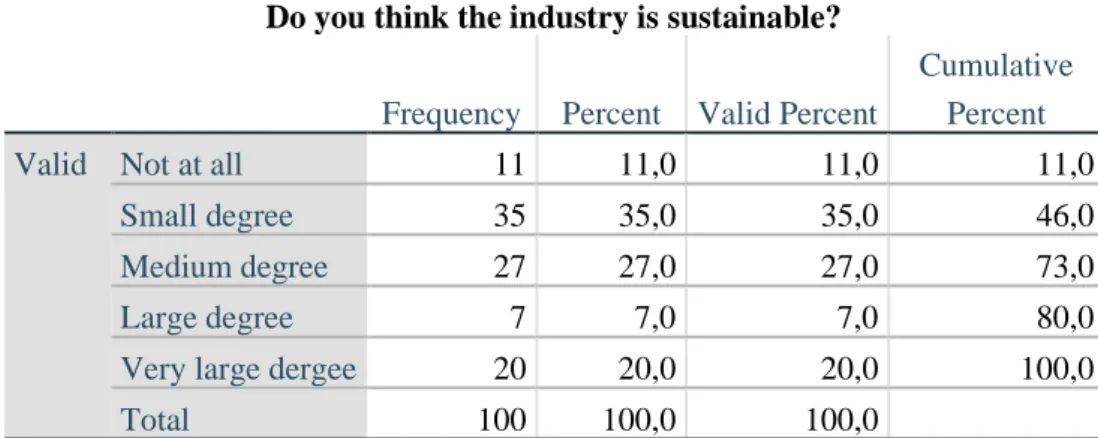
T-test and one way ANOVA
Regarding the professional status of the respondents, we see that there is a statistically significant difference in the cases below, where the owners believe more than the employees in the contribution of the fur industry to the development, economy and investments in the region. Regarding raw material differentiation, there were no statistically significant differences between males and females. Differentiating raw materials (synthetic fur instead of real fur) will benefit the industry in the long run.
Regarding their professional status, statistically significant differences were found in two cases, where the owners seem to be more negative about the perspective of differentiation of raw materials. Regarding the contribution of the fur industry and the years in the fur industry, statistically significant differences were found in only one case. On the contrary, statistically significant differences were found in all cases in the questions of differentiation of raw materials.
To what extent do you think it is possible to differentiate the raw material (synthetic wool instead of real wool).
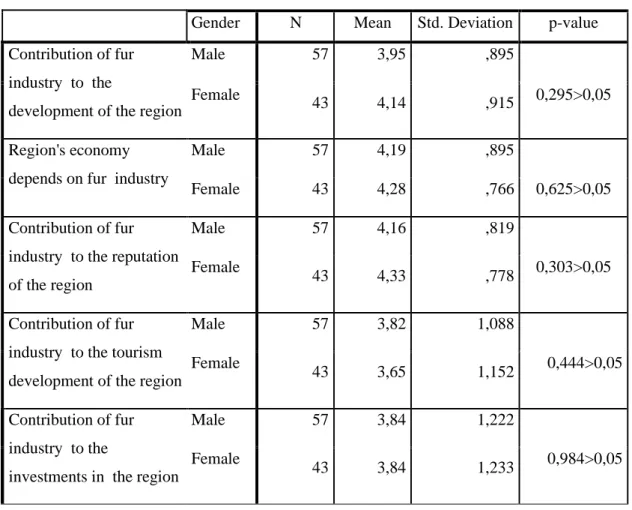
Analysis of the interviews
The fur industry is primarily the largest business, indirectly (with emphasis) and directly employing more than 60% of companies. The next question was "In your opinion, what percentage of the population of this area is directly or indirectly dependent on the fur industry?". In order to understand the importance of the fur industry to the region's economy, the next question was "What percentage of the region's economy do you think is represented by companies directly related to fur?" According to P1, the situation in the past was quite different from today.
I believe the fur industry is poised to last another decade, moving at the pace of the global community and with no new markets on the horizon.” Currently, nothing can change the structure of the fur industry because it is a traditional art, with an ecological character. The next question asked participants to state the official position of the agency they represent on the problems facing the fur industry.
Finally, the representatives were asked to state any proposals regarding the sustainability of the fur industry. Despite the industry's problems, it is the most important economic activity in Kastoria.
Conclusions and policy making proposals
The industry is responsible for the development of the region's wines, while the wool products have made the city famous all over the world. To what extent is the industry believed to have contributed to the development of the region? To what extent do you think the economy of the region depends on the industry?
To what extent do you think the industry contributes to the area's reputation. To what extent do you think the industry contributes to tourism development in the region. To what extent do you think the differentiation of the raw material (synthetic fur instead of real) will affect the following stakeholders.
I would like you to tell me to what extent the industry has contributed to the development of the area. What is the official position of the body represented on the problems in the fur industry.